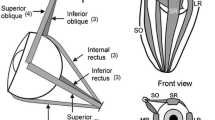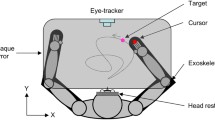Abstract
Eye movements can be broadly classified into target-selecting and gaze-stabilizing eye movements. How do the different systems interact under natural conditions? Here we investigate interactions between the optokinetic and the target-selecting system in cats and humans. We use combinations of natural and grating stimuli. The natural stimuli are movies and pictures taken from the cat’s own point of view with a head-mounted camera while it moved about freely in an outdoor environment. We superimpose linear global motion on the stimuli and use measurements of optokinetic nystagmus as a probe to study the interaction between the different systems responsible for controlling eye movements. Cats display higher precision stabilizing eye movements in response to natural pictures as compared to drifting gratings. In contrast, humans perform similarly under these two conditions. This suggests an interaction of the optokinetic and the pursuit system. In cats, the natural movies elicit very weak optokinetic responses. In humans, by contrast, the natural movie stimuli elicit effectively stabilizing eye movements. In both species, we find a unimodal distribution of saccades for all stimulus velocities. This suggests an early interaction of target-selecting and gaze-stabilizing saccades. Thus, we argue for a more integrated view in humans of the different eye movement systems.









Similar content being viewed by others
References
Araujo C, Kowler E, Pavel M (2001) Eye movements during visual search: the costs of choosing the optimal path. Vision Res 41:3613–3625
Bahill AT, Stark L (1975) Overlapping saccades and glissades are produced by fatigue in the saccadic eye movement system. Exp Neurol 48:95–106
Blakemore C, Donaghy M (1980) Co-ordination of head and eyes in the gaze changing behavior of cats. J Physiol 300:317–335
Crommelinck M, Roucoux A (1976) Characteristics of cat’s eye saccades in different states of alertness. Brain Res 103:574–578
de Brouwer S, Missal M, Lefevre P (2001) Role of retinal slip in the prediction of target motion during smooth and saccadic pursuit. J Neurophysiol 86:550–558
Donaghy M (1980) The contrast sensitivity, spatial resolution and velocity tuning of the cat’s optokinetic reflex. J Physiol 300:353–365
Evinger C, Fuchs AF (1978) Saccadic, smooth pursuit, and optokinetic eye movements of the trained cat. J Physiol 285:209–229
Evinger C, Kaneko CR, Fuchs AF (1981) Oblique saccadic eye movements of the cat. Exp Brain Res 41:370–379
Galley N (1998) An enquiry into the relationship between activation and performance using saccadic eye movement parameters. Ergonomics 41:698–720
Gaymard B, Ploner CJ, Rivaud S, Vermersch AI, Pierrot-Deseilligny C (1998) Cortical control of saccades. Exp Brain Res 123:159–163
Goldberg ME (2000) The control of gaze. In: Kandel ER, Schwartz JH, Jessel TM (eds) Principles of neural science. McGraw-Hill, New York, pp 782–800
Guitton D, Munoz DP, Galiana HL (1990) Gaze control in the cat: studies and modeling of the coupling between orienting eye and head movements in different behavioral tasks. J Neurophysiol 64:509–531
Körding KP, Kayser C, Betsch BY, König P (2001) Non-contact eye-tracking on cats. J Neurosci Methods 110:103–111
Leopold DA, Plettenberg HK, Logothetis NK (2002) Visual processing in the ketamine-anesthetized monkey. Optokinetic and blood oxygenation level-dependent responses. Exp Brain Res 143:359–372
Maioli C, Precht W (1984) The horizontal optokinetic nystagmus in the cat. Exp Brain Res 55:494–506
Missal M, Crommelinck M, Roucoux A, Decostre MF (1993) Slow correcting eye movements of head-fixed, trained cats toward stationary targets. Exp Brain Res 96:65–76
Missal M, Lefevre P, Crommelinck M, Roucoux A (1995) Evidence for high-velocity smooth pursuit in the trained cat. Exp Brain Res 106:509–512
Pierrot-Deseilligny C, Ploner CJ, Muri RM, Gaymard B, Rivaud-Pechoux S (2002) Effects of cortical lesions on saccadic eye movements in humans. Ann N Y Acad Sci 956:216–229
Schweigart G, Mergner T, Barnes G (1999) Eye movements during combined pursuit, optokinetic and vestibular stimulation in macaque monkey. Exp Brain Res 127:54–66
Acknowledgements
This work was supported by the Center of Neuroscience Zürich (C.K.), the SNF (grant number 31-65415.01; P.K.), and the EU/BBW (IST-2000-28127; 01.0208-1; G.M., P.K.). We are grateful to T.C.B. Freeman for comments on previous versions of this manuscript.
Author information
Authors and Affiliations
Corresponding author
Rights and permissions
About this article
Cite this article
Moeller, G.U., Kayser, C., Knecht, F. et al. Interactions between eye movement systems in cats and humans. Exp Brain Res 157, 215–224 (2004). https://doi.org/10.1007/s00221-004-1835-z
Received:
Accepted:
Published:
Issue Date:
DOI: https://doi.org/10.1007/s00221-004-1835-z




